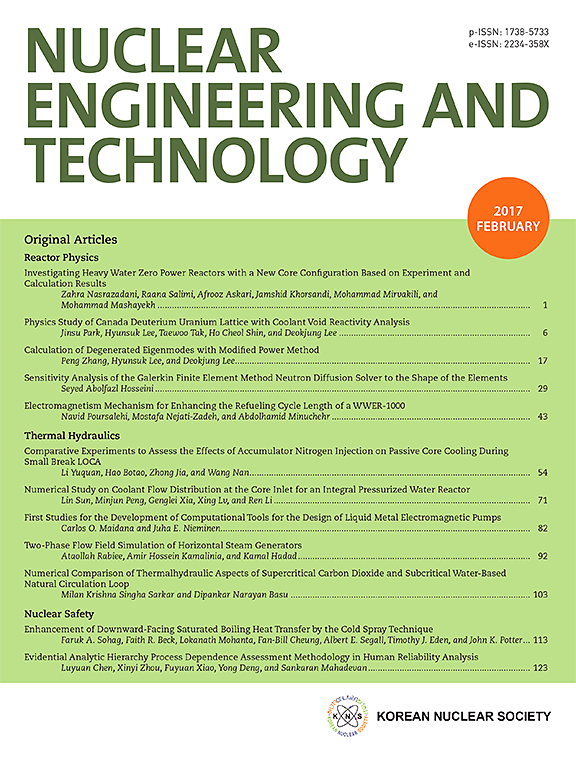基于负离子的中性光束注入光中性化测试系统的构想设计
IF 2.6
3区 工程技术
Q1 NUCLEAR SCIENCE & TECHNOLOGY
引用次数: 0
摘要
中性束注入是磁约束聚变领域有效的加热方法之一,而中和是负离子最关键的环节。为了进一步提高中性束注入功率,提高长脉冲运行能力,优化 NNBI 系统的效率,需要对中和模式进行进一步的研究和验证。从理论上讲,光中和作用可以达到 90% 以上的中和效率。然而,要保持兆瓦级激光腔长时间稳定运行,则会带来相应的挑战。此外,与激光靶相关的成本超过了提高中和效率所带来的收益,导致其至今仍未得到实际应用。本文利用 CRAFT NNBI 四分之一和二分之一尺寸负光源测试设备,设计了单通道多倍光中和验证系统,提出了解决这些问题的方案。文中概述了该系统的测试和诊断方法。对激光靶厚度、负离子能量、光束形状和光中和系统效率等关键参数进行了数值计算。结合负离子源测试平台的实验数据,理论计算表明中和效率可达 63%,系统效率超过 40%。即使增加入射激光功率或反射次数,中和效率也能提高到 95%,同时系统效率也能提高到 60%。在提高入射激光功率的同时保持效率,可将反射次数减少到 10 次左右,达到可接受的临界值。然而,这种调整将使单面反射镜的辐照密度从 660W/mm 增加到 3000W/mm。本文有条不紊地设计了一个实用的激光中和验证平台,有望大幅提高中和效率,方便实际应用和验证。本文章由计算机程序翻译,如有差异,请以英文原文为准。
Conceptional design of photoneutralization test system for negative ion-based neutral beam injection
Neutral beam injection is one of the effective heating methods in the field of magnetic confinement fusion, and neutralization is the most crucial link in the case of negative ions. To further increase the neutral beam injection power, improve the long pulse operation capability, and optimize the efficiency of the NNBI system, further research and verification about the neutralization mode are needed. Theoretically, photoneutralization can achieve more than 90 % neutralization efficiency. However, maintaining stable operation of the megawatt laser cavity over extended periods poses corresponding challenges. Additionally, the cost associated with laser target surpasses the benefit gained from increased neutralization efficiency, leading to its lack of practical application thus far. This paper proposes a solution to these issues by designing a single-channel, multi-fold photoneutralization verification system utilizing the CRAFT NNBI one-quarter and one-half size negative source test equipment. An outline of the system's test and diagnostics approach is provided. Key parameters such as laser target thickness, negative ion energy, beam shape and efficiency of the photoneutralization system are numerically calculated. Combined with the experimental data of the negative source test platform, theoretical calculations show that the neutralization efficiency can achieve 63 % with the system efficiency exceeding 40 %. Even by increasing the incident laser power or the number of reflections, neutralization efficiency can be increased to 95 %, with a simultaneous increase in system efficiency to 60 %. Maintaining efficiency while increasing incident laser power could reduce the number of reflections to approximately ten, reaching an acceptable threshold. However, this adjustment will increase the irradiation density of a single mirror from 660W/mm2 increases to 3000W/mm2. This paper methodically designs a practical laser neutralization verification platform, which is expected to substantially improve the neutralization efficiency, and facilitate practical application and validation.
求助全文
通过发布文献求助,成功后即可免费获取论文全文。
去求助
来源期刊

Nuclear Engineering and Technology
工程技术-核科学技术
CiteScore
4.80
自引率
7.40%
发文量
431
审稿时长
3.5 months
期刊介绍:
Nuclear Engineering and Technology (NET), an international journal of the Korean Nuclear Society (KNS), publishes peer-reviewed papers on original research, ideas and developments in all areas of the field of nuclear science and technology. NET bimonthly publishes original articles, reviews, and technical notes. The journal is listed in the Science Citation Index Expanded (SCIE) of Thomson Reuters.
NET covers all fields for peaceful utilization of nuclear energy and radiation as follows:
1) Reactor Physics
2) Thermal Hydraulics
3) Nuclear Safety
4) Nuclear I&C
5) Nuclear Physics, Fusion, and Laser Technology
6) Nuclear Fuel Cycle and Radioactive Waste Management
7) Nuclear Fuel and Reactor Materials
8) Radiation Application
9) Radiation Protection
10) Nuclear Structural Analysis and Plant Management & Maintenance
11) Nuclear Policy, Economics, and Human Resource Development
 求助内容:
求助内容: 应助结果提醒方式:
应助结果提醒方式:


